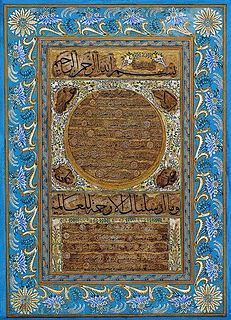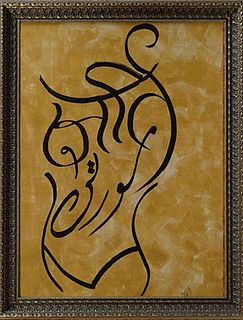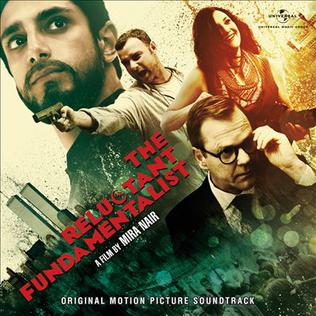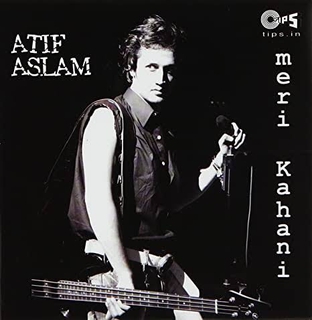
Nastaʼlīq is one of the main calligraphic hands used in writing the Persian alphabet and the Urdu alphabet, and traditionally the predominant style in Persian calligraphy. It was developed in Iran in the 14th and 15th centuries. It is sometimes used to write Arabic language text, but its use has always been more popular in the Persian, Urdu and Turkic sphere of influence. Nastaliq remains very widely used in Iran, Afghanistan and the Indian Subcontinent and other countries for written poetry and as a form of art.

Hassan Massoudy, born in 1944, is an Iraqi painter and calligrapher, considered by the French writer Michel Tournier as the "greatest living calligrapher", currently lives in Paris. His work has influenced a generation of calligraffiti artists.

Syed Sadequain Ahmed Naqvi, often referred to as Sadequain Naqqash, was a Pakistani artist, best known for his skills as a calligrapher and a painter. He is considered as one of the finest painters and calligraphers Pakistan has ever produced. He was also a poet, writing hundreds of rubāʿiyāt in the style of Omar Khayyam and Sarmad Kashani.
Mir Ali Tabrizi was a distinguished Iranian calligrapher of the 14th century, to whom the invention of Nas-Taliq calligraphy style is attributed.

Centaur is a serif typeface by book and typeface designer Bruce Rogers, based on the Renaissance-period printing of Nicolas Jenson around 1470. He used it for his design of the Oxford Lectern Bible. It was given widespread release by the British branch of Monotype, paired with an italic designed by calligrapher Frederic Warde and based on the slightly later work of calligrapher and printer Ludovico Vicentino degli Arrighi. The italic has sometimes been named separately as the "Arrighi" italic.

Truck art is a popular form of regional decoration in South Asia, with Pakistani and Indian trucks featuring elaborate floral patterns and calligraphy.
The Musalman is the oldest Urdu-language daily newspaper published from Chennai in India. It is an evening paper with four pages, all of which are handwritten by calligraphers, before being mass-produced with a printing press. According to Wired and The Times of India, The Musalman is possibly the only surviving handwritten newspaper in the world.

Hâfiz Osman (1642–1698) was an Ottoman calligrapher noted for improving the script and for developing a layout template for the hilye which became the classical approach to page design.
Shair is the oldest Urdu-language literary magazine, based in Mumbai, India. It was launched in Agra in 1930 by the famous poet Seemab Akbarabadi. Its editor-in-chief is the poet, writer and journalist Iftikhar Imam Siddiqui, and the assistant editors are his two brothers, Noaman Siddiqui and Hamid Iqbal Siddiqui.

Samrup Rachna is a form of calligraphic art created by Dr Syed Mohammed Anwer to promote peace and collaboration in the South Asia region where Hindustani is spoken
Aadat is originally a song by Jal band. It was sung by Atif Aslam and composed by Goher Mumtaz. Later it was released in several different versions in Jal's album Aadat by Farhan Saeed and Atif Aslam's solo album Jal Pari. It was also used in the Bollywood films Kalyug and Chocolate.

The Reluctant Fundamentalist: Original Motion Picture Soundtrack is the film soundtrack to the film of the same name, originally composed, orchestrated and conducted by Michael Andrews.The soundtrack was released by Universal Music Group India in Asia and Internationally released by Knitting Factory under Universal rights on April 30, 2013.

Persian Inscriptions on Indian Monuments is a book written in Persian by Dr Ali Asghar Hekmat E Shirazi and published in 1956 and 1958 and 2013. new edition contains the Persian texts of more than 200 epigraphical inscriptions found on historical monuments in India, many of which are currently listed as national heritage sites or registered as UNESCO world heritage, published in Persian; an English edition is also being printed.
Syed Taqi Hassan Abedi is an Indian-Canadian physician who is also poet and scholar of the Urdu language.
Sheikh Mohammed Irfan alias Shaukat Pardesi was a poet, journalist and lyricist born in Malaysia, where his father Sheikh Sahib Ali had migrated from Maroofpur village in Jaunpur district of India. During 1950's Pardesi was associated with Urdu Daily Inquilab for some-time and also acted as the editor of Film Times Weekly magazine. He published and edited an acclaimed monthly Urdu magazine titled Munna for children. The writings of eminent writers like Niaz Fatehpuri, Ale Ahmad Suroor, Faiz Ahmed Faiz, etc. had supported Munna magazine during that time. His ghazals and nazms were published in almost all known Urdu journals and were recorded by HMV in the melodious voices of various famous singers of his time viz. Talat Mahmood, Manna Dey, C. H. Atma, Anup Jalota, Dilraj Kaur, Shailendra Singh, Shyam Lala, Mukesh and others.
Nakajima Hiroyuki is a contemporary Japanese artist and calligrapher from Chiba, Japan. He is best known for his modern interpretation of Japanese calligraphy (shodo) which he calls Sho art, a technique which combines the traditional elements of Japanese calligraphy (shodo) with the movements of Tai Chi and inspired by the symbols of zen and nature. Nakajima currently has studios in Chiba, Japan and Milan, Italy.

Hassan Sobhi Mourad was an academic, a calligrapher, an artist, a researcher, an author and a poet. He specialized in Arabic Calligraphy, its development and teaching, drawing to all age groups, as well as contributing in writing art-related articles. Born in Syria, Hassan Mourad lived abroad in various countries and continents for over thirty-five years due to his career in diplomatic service. Though living abroad for most of his adult life, he remained passionate about the Arabic Language, its history and the art of Arabic Calligraphy. Mourad was influenced at the early age of 14 by a fellow Syrian writer without having ever met him; this artist, AbdulRahman Fakhoory, predicted a bright future in art for Mourad.

Hashem Muhammad al-Baghdadi (1917-1973) was an Iraqi master calligrapher, noted for his lettering which exhibited a steadiness of hand and fluidity of movement. In his later life, he was acknowledged as the "imam of calligraphy" across the Arab world, and would be the last of the classical calligraphers. He also authored several important texts on the art of calligraphy.
Qamar Dagar is an Indian calligrapher. She is the founder of the Qalamkaari Creative Calligraphy Trust. In 2016, she was awarded the Nari Shakti Puraskar, India's highest civilian award for women.

After the success of first two albums, Atif Aslam released his third solo album Meri Kahani in 2008. This album was produced by Sarmad Abdul Ghafoor.












